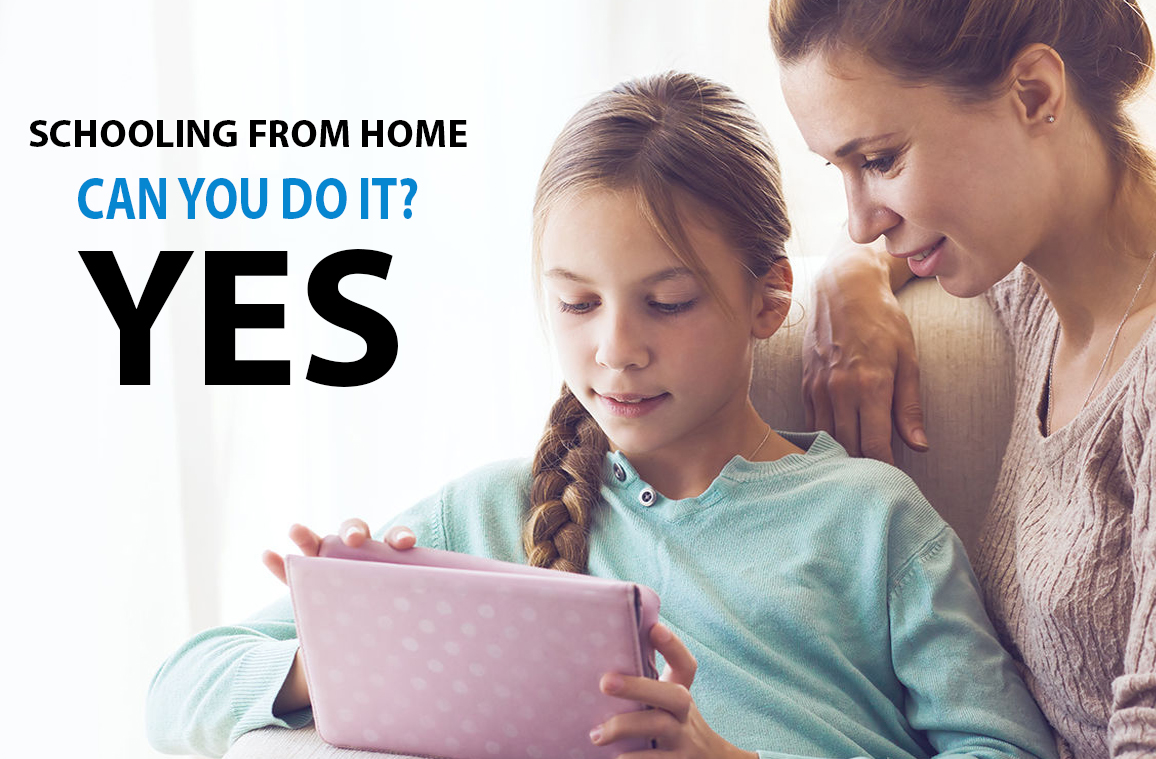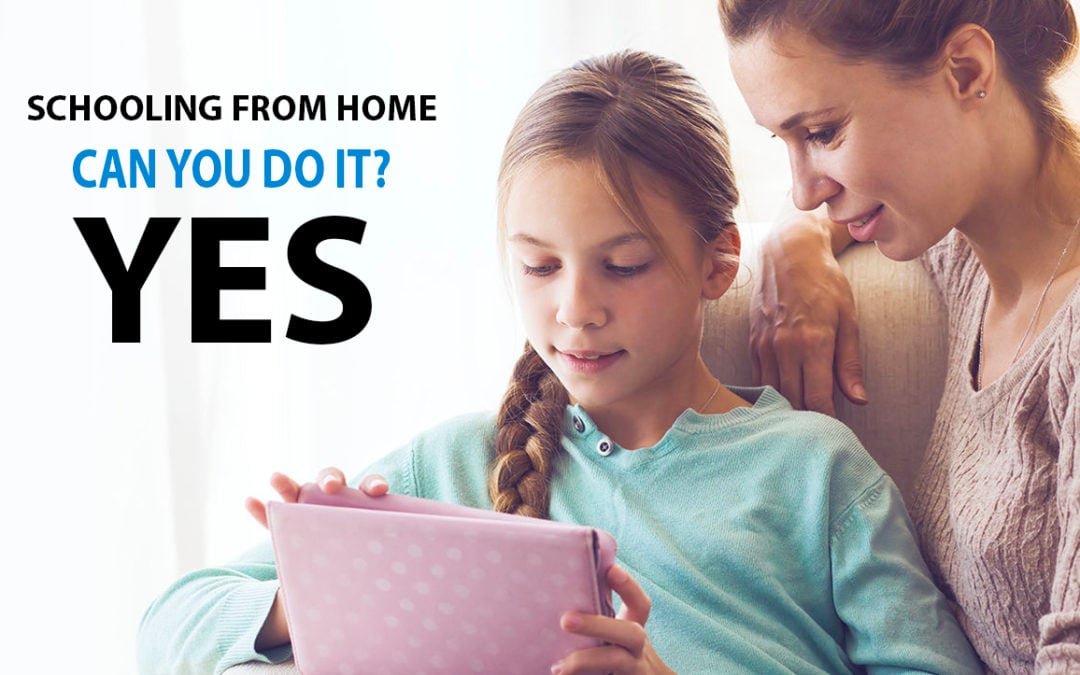Like it or not, when Fall rolls around, many of us may need to school from home whether it’s our first choice or not.
What if your student is dyslexic? Can it possibly work?
There are a lot of people who can’t see schooling from home working for their student, but what I can tell you is that over the years, Brock and I have seen every type of schooling for every type of student and when there’s a will, there’s a way.
 THERE IS NO ONE-SIZE FITS ALL
THERE IS NO ONE-SIZE FITS ALL
Schooling from home doesn’t have to mean mom and dad at the kitchen table with a little chalkboard.
Parents can work from home and also have their children fully educated. You don’t have to replicate an entire school day at home. Many parents are surprised how much shorter the direct education time takes for students at home. What school looks like can differ dramatically between students, but almost every homeschooling parent we ever talked to said they were surprised how little time it took to school them – and also with so much less stress.
If school was a stressful experience for your student, you may see the`ir old selves return again.
How many hours did it take? That depends. My recall was that it was usually a few hours a day – with the time broken up into smaller parts and a mix of online activities as well as one-on-one time.
One upside of homeschooling is the ability to tailor the time of certain subjects to the student rather than the other way round.
You also don’t need to cover every subject every day. I think we did math 2-3 times per week and we did online math for both kids, although we tried a variety of programs until we found a good match for our kids.
DIFFERENT GOALS FOR DIFFERENT STUDENTS
Even if you decided to homeschool for the coming year, you can have very different goals for each child. Would you like to homeschool one child to allow him to intensively remediate in reading? Or do you have plans to remote school just until the pandemic and pandemic policies seem to be under better control?
If you plan to school from home only one year, you might want to be in touch with your local school to see if they might share their curriculum so that rejoining (if you want to) would be a smoother process in a year.
If you’re opening to homeschooling for more than a year, you have more flexibility for school planning. Some parents choose interest-based unschooling with the idea that reading, writing, and math will somehow be worked in. Others may instead put the focus on reading, writing, and math, and work interests and perhaps documentary watching into time left over.
Many public schools have distance learning programs that allow parents access to a teacher who will supervise your student’s plan, but also free resources, including books, curricula, software, and extracurriculars free to families and paid for by federal student funds. Many private schools (including those specifically for dyslexia) may also have homeschool programs in which students receive specialist teacher time once or several times per week.
WHAT ABOUT MOM, DAD, OR ANOTHER FAMILY MEMBER BECOMING AN ORTON-GILLINGHAM TUTOR?
As almost anyone in this field knows, some of the most talented tutors and curriculum creators in this field have a personal connection to dyslexia, whether it was their child, grandchild, niece, or nephew…and the field is much richer for it.
If your student needs intensive remediation through a comprehensive structured literacy program, a few months or year of focused remediation could significantly improve their decoding abilities and set them on a better path whenever they return to school.
Because of the pandemic, all of the curriculum providers have had to provide more resources and support for parents, teachers, and tutors who are adopting their curricula. Some programs (like Sonday All About Learning or Barton) have extensive support resources like videos to help parents or other non-professionals know how to present lessons. Other programs, like LIPS or Wilson require more teacher prep, but remote tutors can be arranged from private schools for dyslexia like Churchill Center and School or the curriculum providers themselves.
Sometimes parents may want to try and tackle the remediation process themselves, especially if sessions are short and instructions straightforward. Most curricula have introductory lessons on line so that families can tryout different programs and see how easy or hard they may be to work for them.
Because students know all routines have been upset because of the pandemic, pivoting students to a new plan also doesn’t have the associated baggage such as being taken out of school or held back because of “failure.”
WHAT ABOUT THE OLDER GRADES OR PRE-COLLEGE YEARS?
In many respects, homeschooling older students can be easier, not harder. Older students can be more independent with their studies and now it’s possible to have a great more flexibility in what classes get scheduled and over what period of time.
Dyslexic students often have higher conceptual abilities than output speed. The gaps narrow over time, but through much of K-12, a large gap exists. As a result, for some students – letting them pursue more advanced classes in area of interest – especially if there are fewer other classes at the same time or lower output demands (written work, papers) can give students more confidence in their intellectual abilities at a time that is some important for them thinking about what their career future holds for them.
In junior high, we know of many students who homeschooled by taking 1-2 online advanced classes at one time. They could immerse themselves in one subject, learn academic writing at the same time, gaining confidence in their abilities without becoming overloaded. Taking the classes for credit can also help them if they choose to later rejoin a traditional in-class school.
For the high school years, parents and students may become more anxious that they should return to traditional schooling, but often those who resist the pull find things better outside of traditional K-12 rather than worse. Middle school can become a torture for some students, as an impossible amount of work assigned, social pressures and bullying take their toll. This is also a period were teen brains reorganize and many systems may be in flux; having more time and grace to ‘get things together’ can be a gift. Many students do get things together in upper middle school, so that if they want return to brick and mortar schools in high school, the timing may be ripe.
Many homeschooling students choose to return in high school with the intention of transitioning back to traditional brick and mortar schools for sports, extracurricular and social reasons, and even the idea that high school may be “pre-college.” Some transition smoothly, while others may not. If problems with the transition happen, often difficulties arise with over-ambitious courseloads, inconsistent or denied accommodations, and unrealistic course expectations.
Some students find a better match taking some community college classes instead of high school. At the community college level, there are more student supports, often a designated LD support office and free or low cost tutors. Students can also take advantage of the high school years to acquire college credits – through community college classes, CLEP multiple choice exams, or AP exams.
There were so many variations on everything that we saw in education over the years we were in practice; not everything worked that was tried, but with time, all of the families we worked with found a plan that really worked for their students, and today its a beautiful thing to see them happy and successful in paths that they chose for themselves.















